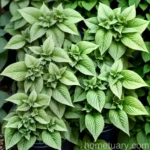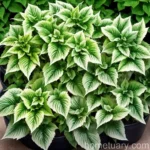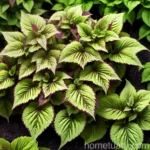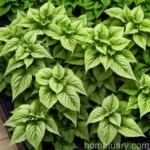Swedish Ivy (Plectranthus ‘Mona Lavender’): The Complete Guide
What is Plant: Swedish Ivy (Plectranthus ‘Mona Lavender’)
Swedish ivy, botanically known as Plectranthus ‘Mona Lavender’, is a delightful and versatile plant that is beloved by both novice and experienced gardeners. Despite its common name, it is neither Swedish nor an ivy but genotypically and phenotypically resembles more to mint family, Lamiaceae. This herbaceous perennial is a remarkable display of natural beauty, with its unique purple-tinged leaves and charming flowers. Its versatility makes it an ideal choice for various indoor and outdoor settings, as it thrives as a hanging basket, container or bedding plant.
Key Takeaways: Swedish Ivy (Plectranthus ‘Mona Lavender’)
Before delving into the specifics of caring for Swedish Ivy, let’s quickly skim through some key takeaways about this versatile plant:
- Scientific Name: Plectranthus ‘Mona Lavender’
- Plant Type: Herbaceous Perennial
- Preferred Growing Zones: USDA Zones 9-11
- Light Requirements: Partial to full sun
- Watering Needs: Moderate watering
- Soil Type: Well-draining, fertile soil
- Mature Height: 12-18 inches (30-45 cm)
- Growth Habit: Spreading and trailing
- Flowering Period: Late spring to mid-fall
- Common Uses: Hanging baskets, containers, and ground covers
- Key Features: Purple-tinged foliage, attractive flowers, and air-purifying properties
Now, let’s explore the comprehensive care guide for Swedish Ivy, covering various aspects including its culture, uses, watering, sunlight, fertilization, soil preferences, pruning, propagation, and managing common diseases and pests.
Culture of Swedish Ivy (Plectranthus ‘Mona Lavender’)
The culture of Swedish Ivy encompasses the environment and conditions necessary for its healthy growth and development. Understanding its cultural requirements is pivotal in ensuring its thriving presence in your garden or indoor space. Let’s delve into the intricacies of its culture.
Water
Swedish Ivy thrives in moderately moist conditions but is extremely sensitive to overwatering. It is crucial to maintain a balance, allowing the top inch of the soil to dry out before watering again. During the active growing season, generally in spring and summer, regular watering is essential. However, in the dormant period, which typically occurs in winter, the watering frequency should be significantly reduced to prevent waterlogged soil and potential root rot.
Sunlight
In terms of sunlight requirements, Swedish Ivy favors bright, indirect light. It can tolerate short periods of direct sun exposure, especially during the morning hours, but prolonged exposure to intense sunlight can scorch its delicate leaves. Therefore, positioning it in a location with partial shade, such as an east-facing window, or providing filtered sunlight outdoors, is ideal for its overall well-being.
Fertilizer
When it comes to fertilization, Swedish Ivy benefits from regular feeding with a balanced, water-soluble fertilizer during the growing season. Application should typically occur every 2-4 weeks, following the manufacturer’s instructions for dilution and application rates. However, it’s important to refrain from fertilizing during the winter months when the plant is in its dormant phase.
Soil
Optimal soil conditions are critical for Swedish Ivy to thrive. It prefers well-draining, fertile soil that retains adequate moisture without becoming waterlogged. A high-quality potting mix suited for indoor plants or a rich garden soil with added organic matter can provide the ideal growing medium for this plant.
Pruning
Regular pruning is beneficial for Swedish Ivy to maintain its compact, bushy shape and encourage continuous growth and flowering. It is advisable to trim back leggy or straggly growth, as well as spent flowers, to promote a denser and more floriferous habit. Pruning also aids in controlling its size and enhancing its overall aesthetic appeal.
Propagation
The propagation of Swedish Ivy is relatively straightforward and can be accomplished through stem cuttings. This method involves taking 4-6 inch (10-15 cm) cuttings from the parent plant, removing the lower leaves, and placing the stems in a moist potting mix. With favorable conditions and consistent moisture, the cuttings will develop roots within a few weeks, giving rise to new plants that can be transplanted into individual containers or incorporated into the garden.
Uses of Swedish Ivy (Plectranthus ‘Mona Lavender’)
Swedish Ivy is a multifaceted plant that offers a myriad of uses, making it a versatile and cherished addition to any indoor or outdoor space. Let’s explore some of its common applications and the value it brings to various settings.
-
Container Plant: Due to its compact growth habit and trailing nature, Swedish Ivy is an enchanting choice for container gardening. It thrives in hanging baskets, window boxes, and decorative planters, adding a touch of natural elegance to porches, balconies, and patios.
-
Bedding Plant: When mass-planted in garden beds or borders, Swedish Ivy creates a captivating ground cover, forming a lush carpet of vibrant foliage. It is particularly striking when combined with contrasting plants, showcasing its unique coloration and textural appeal.
-
Indoor Plant: Recognized for its air-purifying properties, Swedish Ivy makes a remarkable indoor plant, enhancing air quality and adding a refreshing ambiance to homes, offices, and indoor spaces. Its low-maintenance nature and ornamental features make it an excellent choice for interior decoration.
Common Diseases of Swedish Ivy (Plectranthus ‘Mona Lavender’) and Disease Diagnosis
While Swedish Ivy is generally resilient to most pests and diseases, it is susceptible to a few common issues that can impact its health and vigor. Understanding these potential ailments and their diagnosis is essential for effective management and intervention when necessary.
Common Diseases
Powdery Mildew
Powdery mildew, caused by various fungal species, can affect Swedish Ivy, resulting in a powdery white coating on the foliage. This condition typically arises in humid or poorly ventilated environments, and it can compromise the plant’s overall health if left unchecked.
Root Rot
Excessive moisture and waterlogged soil can lead to the development of root rot, a fungal disease that affects the roots of the plant. This can manifest as yellowing or wilting of foliage, stunted growth, and a general decline in the plant’s condition.
Disease Diagnosis
Early detection and accurate diagnosis of ailments are pivotal in addressing disease issues promptly and effectively. Regular inspection of the plant for unusual symptoms such as discoloration, distortion, or abnormal growth can aid in identifying potential disease concerns. Additionally, monitoring environmental conditions, such as humidity levels and watering practices, can help preemptively manage disease development.
Common Pests Affecting Swedish Ivy (Plectranthus ‘Mona Lavender’)
Pest infestations can pose a threat to the health and appearance of Swedish Ivy, necessitating vigilance and proactive measures to mitigate their impact. Let’s explore some of the common pests that may target this plant and the methods for managing their presence.
Aphids
Aphids are small, sap-sucking insects that can congregate on the foliage of Swedish Ivy, causing damage such as stunted growth, leaf distortion, and the secretion of honeydew. Regular inspection and the application of horticultural oil or insecticidal soap can help control aphid populations.
Spider Mites
Spider mites are microscopic pests that commonly infest Swedish Ivy, especially in dry and warm conditions. Their feeding activity results in stippled, discolored foliage and fine webbing on the plant. Maintaining adequate humidity levels and utilizing natural predators or miticides can aid in managing spider mite infestations.
Mealybugs
Mealybugs are soft-bodied insects that feed on plant sap and can cluster on the stems and leaf axils of Swedish Ivy. Their presence may lead to wilting, yellowing, and the secretion of sticky honeydew. Physical removal, insecticidal sprays, or introducing predatory insects are some of the methods for controlling mealybug populations.
Botanist’s Tips for Growing Swedish Ivy (Plectranthus ‘Mona Lavender’)
As a plant scientist with a penchant for Swedish Ivy, I am delighted to share some expert tips for successfully cultivating and caring for this captivating plant. These insights are derived from rigorous research, practical experience, and a deep appreciation for the natural world.
-
Optimal Growing Conditions: Providing Swedish Ivy with a well-balanced environment encompassing appropriate light, moisture, and nutrition is fundamental for its sustained vitality and ornamental appeal.
-
Prudent Watering: Exercise caution and attentiveness in watering, ensuring the soil maintains a consistent level of moisture without becoming waterlogged. Balance is key to preventing drought stress and excess moisture-related issues.
-
Regular Monitoring: Regularly observe and inspect your Swedish Ivy for any signs of pest infestations, disease symptoms, or nutritional deficiencies. Timely intervention is crucial for maintaining its health and preserving its aesthetic allure.
-
Gentle Pruning: When pruning Swedish Ivy, adopt a gentle approach, removing leggy growth and spent flowers while preserving the plant’s natural form. Pruning aids in rejuvenation and enhances its overall appearance.
-
Encouraging Propagation: Embrace the joy of propagating Swedish Ivy through stem cuttings, a rewarding and straightforward method that allows you to expand your collection and share the beauty of this plant with others.
Fun Facts about Swedish Ivy (Plectranthus ‘Mona Lavender’)
Discovering intriguing and captivating facts about plants can deepen our appreciation for their beauty and significance. Here are some delightful fun facts about Swedish Ivy that will enrich your understanding and admiration for this remarkable plant:
-
Natural Air Purifier: Swedish Ivy serves as a natural air purifier, effectively removing indoor pollutants and enhancing air quality through its adaptive and cleansing properties.
-
Diverse Varieties: While ‘Mona Lavender’ is a popular cultivar, Swedish Ivy is available in an array of varieties, showcasing an assortment of leaf shapes, colors, and growth habits that cater to diverse aesthetic preferences.
-
Medicinal Folklore: In certain cultures, Swedish Ivy has been historically associated with medicinal uses, believed to possess properties that alleviate stress, soothe the senses, and promote overall well-being in traditional remedies.
Links to External Resources
To further enrich your knowledge and exploration of Swedish Ivy, discover valuable resources and insights from trusted sources in the botanical realm:
- Royal Horticultural Society (RHS) – Plectranthus ‘Mona Lavender’
- University of Florida IFAS Extension – Plectranthus ‘Mona Lavender’
- The American Phytopathological Society (APS) – Common Plant Diseases
- The Spruce – Common Houseplant Pests and How to Get Rid of Them
- National Garden Bureau – Resources for Home Gardeners
Conclusion
Swedish Ivy, with its alluring foliage, remarkable versatility, and remarkable resilience, stands as an enchanting presence in the world of horticulture and indoor gardening. By comprehensively understanding its culture, uses, care requirements, and insights from botanical expertise, enthusiasts and novice gardeners alike can cultivate and appreciate the captivating beauty of Plectranthus ‘Mona Lavender’. Embrace the joy of nurturing this captivating plant, and let its ornamental allure and beneficial qualities enrich your living spaces and garden landscapes.
As we conclude this comprehensive guide, I hope it has provided you with valuable knowledge and inspiration to embark on a rewarding journey of caring for and cherishing Swedish Ivy. May the vibrant foliage and captivating blooms of this esteemed plant bring joy, tranquility, and botanical wonderment into your botanical endeavors and everyday life.
Happy gardening!
This blog post is for informational purposes only and does not intend to provide medical or professional botanical advice. Always consult with a certified horticulturist or botanist for specific plant care recommendations and guidelines.
References:
– Royal Horticultural Society. “Plectranthus ‘Mona Lavender’.” https://www.rhs.org.uk/Plants/308872/i-Plectranthus-i-Mona-Lavender/Details
– University of Florida IFAS Extension. “Plectranthus ‘Mona Lavender’.” https://gardeningsolutions.ifas.ufl.edu/plants/ornamentals/mona-lavender.html
– The American Phytopathological Society. “Common Plant Diseases.” https://www.apsnet.org/edcenter/disandpath/common/pages/default.aspx
– The Spruce. “Common Houseplant Pests and How to Get Rid of Them.” https://www.thespruce.com/houseplant-pests-4773271
– National Garden Bureau. “Resources for Home Gardeners.” https://ngb.org/resources-for-home-gardeners/















